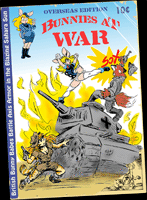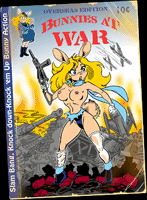A Footnote on "Bunnies at War," c. 1943-c.1950(?)
By W. Wentz
 Anyone who has watched old film documentaries of World War II will have noticed some scenes of enlisted men reading comic books in their rare moments of relaxation.
Anyone who has watched old film documentaries of World War II will have noticed some scenes of enlisted men reading comic books in their rare moments of relaxation.
Many of those men were, after all, barely out of boyhood, and comic books remained a favored reading material for young enlisted men on all fronts.
Most of those comics were designed for children. This shortcoming was noted by several Red cross volunteers at overseas entrepots, and suggestions were sent to the publishers for a more adult variety of comics designed for the military.
The proposal was largely ignored as unprofitable by most publishers, but at least one small, patriotic publishing house took up the challenge... and the remarkable result was "Bunnies at War," a very early example of the "funny animals" genre, that--in the words of one veteran--"did not insult either the intelligence or the masculinity of the fighting man."
 Research into this little-known but surprisingly sophisticated series is hampered by the fact that so few examples survive, and--due to the devotion of the original readership--even fewer have been seen on the market. Due to wartime constraints, circulation was never large, and most copies of "Bunnies at War" were hauled about, handled and re-read by their owners until they literally disintegrated. Of the few examples I have seen, virtually all were in very worn condition, or incomplete--some represented by only a single tattered page. Covers and large splash panels are particularly rare, perhaps because they were removed for pinups.
Research into this little-known but surprisingly sophisticated series is hampered by the fact that so few examples survive, and--due to the devotion of the original readership--even fewer have been seen on the market. Due to wartime constraints, circulation was never large, and most copies of "Bunnies at War" were hauled about, handled and re-read by their owners until they literally disintegrated. Of the few examples I have seen, virtually all were in very worn condition, or incomplete--some represented by only a single tattered page. Covers and large splash panels are particularly rare, perhaps because they were removed for pinups.
The cheap pulp paper on which these comics were printed was never intended for longevity, and--due to paper rationing--print runs were apparently short. Also, the "high brass" apparently had no time and perhaps no interest in the military-comic-book project, and as a result the books had a very low priority in crucial overseas shipping. Perhaps for all these reasons, even the Library of Congress does not have a file of this comic. It was truly an orphan of the war.
 The origins of "Bunnies at War" are obscure, and will likely remain so until some researcher with more time and resources takes up the study.
The origins of "Bunnies at War" are obscure, and will likely remain so until some researcher with more time and resources takes up the study.
On the inside front cover of issue #3 appears a facsimile of a letter from R. L. Dives of the American Red Cross, issuing the challenge to the comics publishers which apparently inspired the project. Along the bottom of the page is a copyright notice, "© 1943 by PS&G Co, Peoria, Ill." This name does not appear in any index of comics publishers I have seen.
The identity of the artist and writers of "Bunnies at War" also remains a mystery--or even whether they were all one person. No bylines appear anywhere in the books, although the artist is as good or better than most comic-book artists of that time.
I have been unable even to find close resemblances to other comics of the 1940s. The book is simply too unique, bearing little resemblance to anything else being done at the time... or for years afterward. The artist seems at least partly inspired by Al Capp's voluptuous mountain women and Tex Avery's long-stemmed cartoon beauties. There existed cartoon animals aplenty, but none so appealingly humanized as these. There were "funny-books" by the dozen, but none written with this strangely-addictive mix of reality, fantasy, whimsy, satire, adventure, eroticism and pathos.
 Nowhere is this complex, multi-layered writing style more apparent than in issue #3, in the story "Underneath the Arches," which begins as a typical spy-verus-spy thriller, with the heroine hunting and being hunted by a Nazi saboteur through the London underworld. In one six-panel page at the finale are depicted physical and intellectual conflict, intense erotic attraction, high comedy and vain regrets--a little masterpiece of concise, powerful storytelling.
Nowhere is this complex, multi-layered writing style more apparent than in issue #3, in the story "Underneath the Arches," which begins as a typical spy-verus-spy thriller, with the heroine hunting and being hunted by a Nazi saboteur through the London underworld. In one six-panel page at the finale are depicted physical and intellectual conflict, intense erotic attraction, high comedy and vain regrets--a little masterpiece of concise, powerful storytelling.
By contrast, a lengthy sequence in issue #5, an erotic episode involving the heroine, a Bristish WREN and MI5 agent, and an American fighter pilot, is expansive, superficially simple--and startlingly graphic, even by today's standards. Yet it perfectly reflects the hurried, intense, haunted romances of the times, even to the girl's bittersweet farewell to the sleeping pilot at the end.
Predictably, any visual depiction of sexuality--even in funny animals--aroused the ire of official meddlers. Gordon D. Twilley, the veteran quoted above, cites the amusing example of one deskbound USAAF squadron exec in England, who issued the order:
 "Re: Pornographic Comic Books.
"Re: Pornographic Comic Books.
"The comic book titled 'Bunnies at War' is deemed pornographic, and all examples are to be surrendered at once to this office, particularly issue # 5, if it still has its cover."
It is doubtful the sly little officer ever got his issue # 5. Due to all the negative factors affecting its distribution and its apparently very irregular publishing schedule, there were never enough "Bunnies at War" to come close to filling the demand. Other comics were skimmed and discarded or traded away; "Bunnies at War" was eagerly acquired, repeatedly read, jealously hoarded, and loaned only with reluctance.
One issue, #18, has the distinction of being the only American comic book suppressed by the British M15 during the war. Judging from the illustrated preview in the previous issue, the story "The Devil's Broomstick" was to be based on the German V-1 "buzz bomb" being launched against England at the time. Shortly after #18 was distributed in England, somebody in Bristish intelligence apparently saw it and went ballistic. Perhaps some detail in the comic revealed something M15 didn't want generally known. All copies were seized, at the insistence of our British allies, and apparently destroyed. At any rate, I have been unable to find anybody who will admit to having seen this story since it first appeared, 50-odd years ago.
 Patrick O'Malley, a B-24 gunner based in England during the war, is a retired auto mechanic I interviewed in 1997. He remembered buying "Bunnies at War" #18 two days before the flap, and enjoying it immensely.
Patrick O'Malley, a B-24 gunner based in England during the war, is a retired auto mechanic I interviewed in 1997. He remembered buying "Bunnies at War" #18 two days before the flap, and enjoying it immensely.
"It was a real good one," he recalled. "One of the very best. Had this cute bunny secret agent infiltrating the German V-1 base at Pennemunde, ending up riding in one of the things--funny as all get-out. I only got to read it once, and then two big MPs and a British officer showed up at the barracks, and the Brit took it away from me and locked it into a briefcase and that was the last I saw of it.
"Later, the old man made me swear I'd never had time to read it. Otherwise, he said, they'd have to take me off flying status, because the Germans might shoot us down and capture me."
In fact, O'Malley's bomber was shot down, on his very next flight. Fortunately, however, he fell in with the Resistance rather than the Nazis. He only made it back to home base after his bunkmates, in keeping with the thrifty custom of the time, had already divided or sold his personal property--including his near-complete collection of "Bunnies at War."
 "That was the last damn Bunny comic I ever saw," he recalled sadly.
"That was the last damn Bunny comic I ever saw," he recalled sadly.
It seems fitting that in a publication whose origins are so obscure, even the date of its demise is unknown. Although Twilley is of the opinion that "Bunnies at War" continued publication at least until the late 1940s, I have found little evidence to support this theory.
And the book would be out of place in the postwar world, anyway.
"Bunnies at War" was, after all, a child of the war, in tune with the spirit of the times. Once the hectic, heroic, free-wheeling and fear-driven ebullience of the war years had declined into the complacent, straitlaced, acquisitive early 1950s, there no place left for this odd little book--except in the fading memories of a generation of once-youthful soldier-citizens, and in a few musty footlockers tucked away in garages or attics of identical Miltown homes.
SOURCES:
"Bunnies at War," #3, #5, #7, #9 (?), #13 (?), #15 #16, #17
PS&G Co., Peoria, IL., 1943-1946 (?)
"The Comic Book as a Mirror to War, Thesis for Master of Fine Arts Degree," Gordon D. Twilley,
University of Oregon School of Fine Arts, Eugene, OR. 1948 (Unpublished)
Interview with Patrick O'Malley, October, 1997.